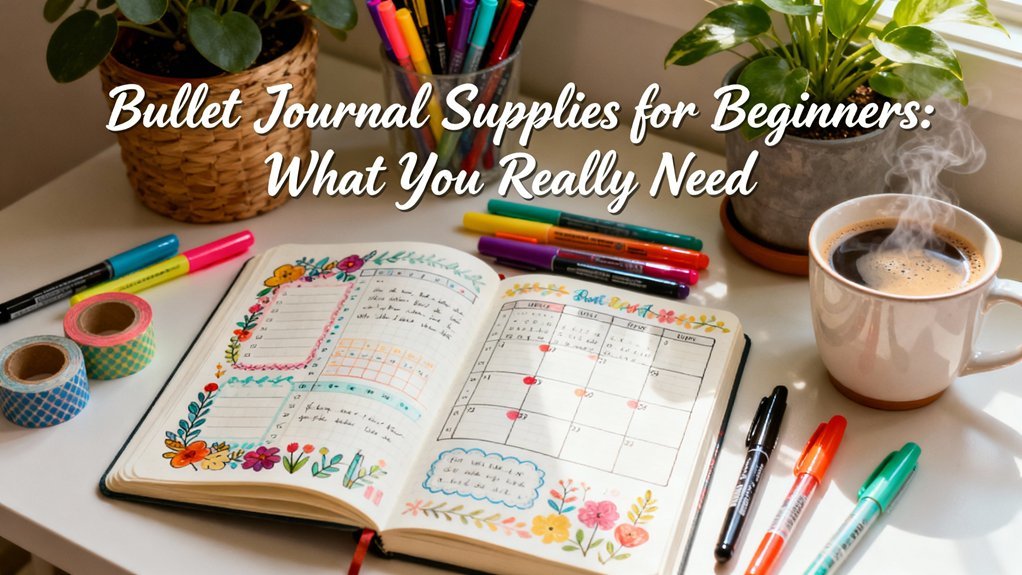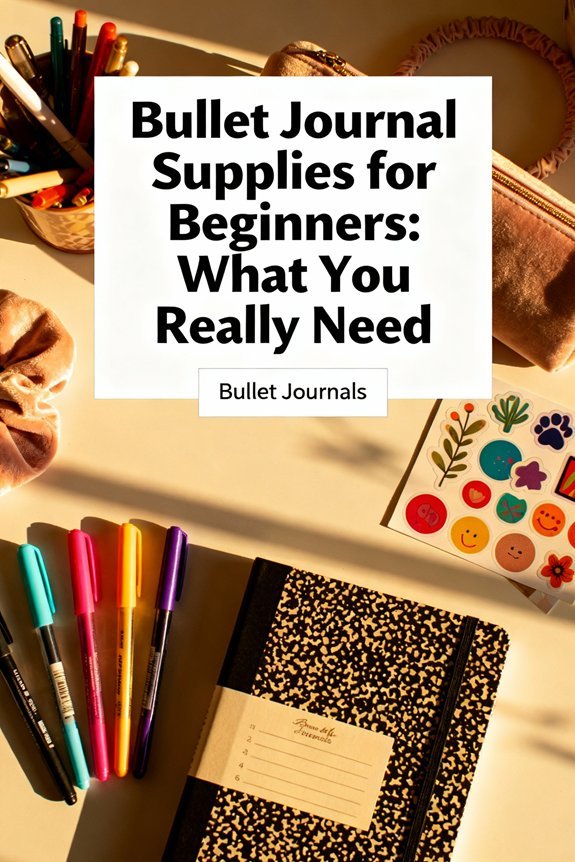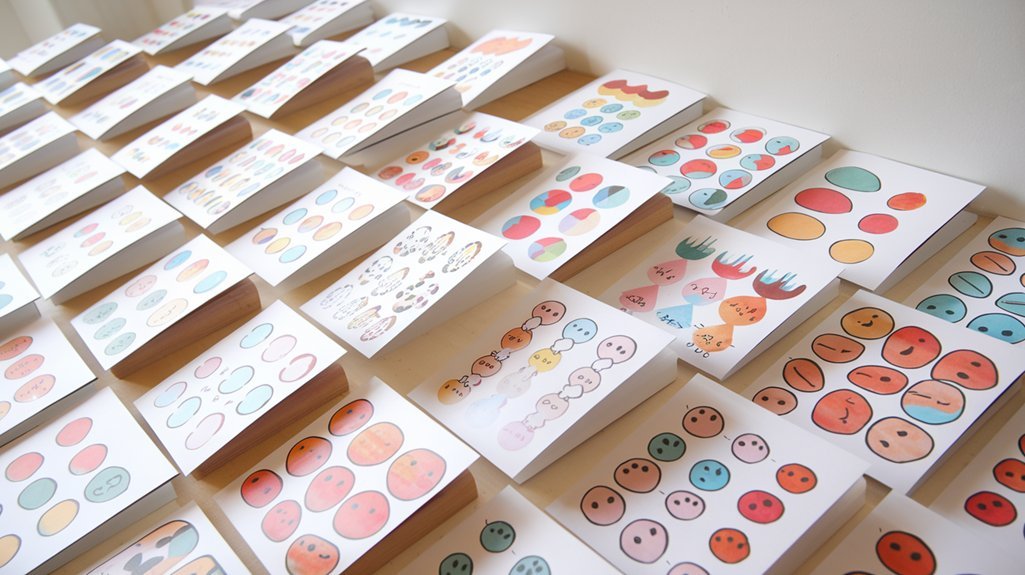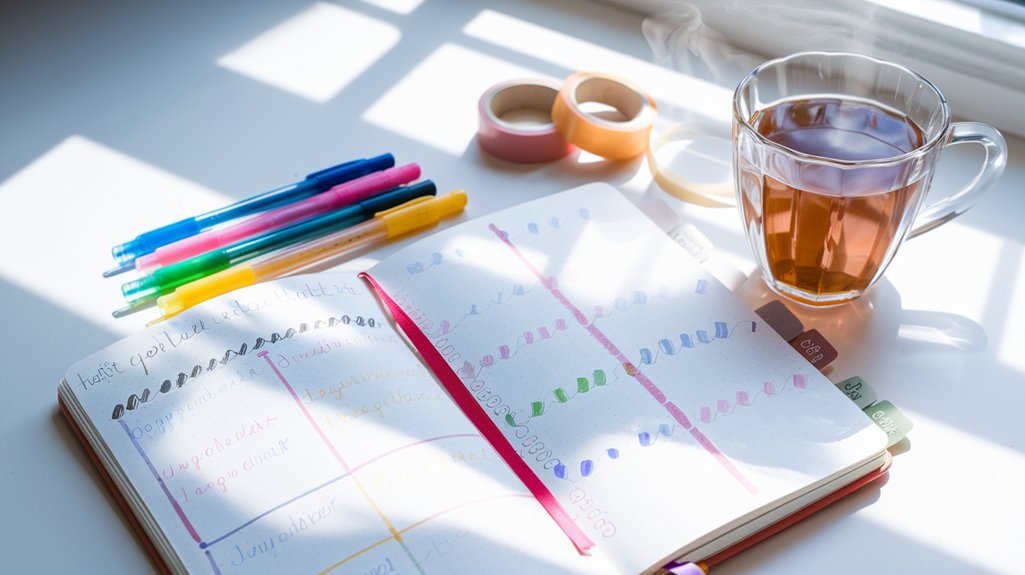You'll need just two items to start bullet journaling: a notebook and a pen. Choose a dot grid notebook with 80-100 gsm paper that prevents bleed-through, and pair it with a quick-dry ballpoint or gel pen that writes smoothly without smudging. Don't invest in expensive supplies or decorative accessories yet—the system's power comes from its framework, not fancy tools. Test basic supplies first, then add functional items like rulers or tabs only when you've identified specific needs through actual use.
Key Takeaways
- Start with only a notebook and pen; specialty journals and decorative accessories are unnecessary for effective bullet journaling.
- Choose dot grid notebooks with 80-100 gsm paper for balanced structure, durability, and minimal ink show-through.
- Select one quick-dry ballpoint or gel pen that writes smoothly and comfortably to avoid decision fatigue.
- Prioritize functionality over aesthetics; expensive supplies don't improve the method's effectiveness or your planning success.
- Test budget options first, purchase single pens for evaluation, and expand supplies gradually based on actual needs.
The Only Two Essential Items You Need to Start
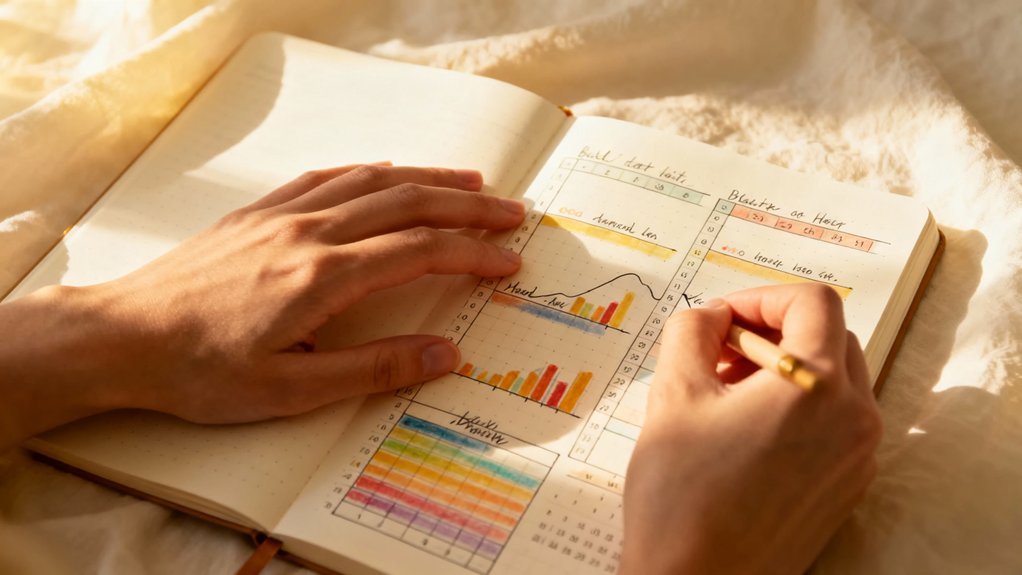
Strip away the marketing hype and trendy accessories—bullet journaling requires only two items: a notebook and a pen.
That's it. You don't need specialty journals, colorful markers, or elaborate stencils to implement this productivity system. The original bullet journal method was designed around simplicity, not supplies.
For your notebook, choose something durable with pages that won't bleed through. Standard ruled, dotted, or blank pages all work—pick what supports your workflow. Size matters less than portability and comfort.
Your pen should write smoothly without smudging. Test it on paper similar to your notebook's before committing.
These starter supplies let you focus on what matters: building a personalized organizational system.
Once you've established your routine, you'll understand which additional essential tools genuinely improve your practice. Starting minimal prevents overwhelming yourself with options and keeps you centered on developing the habit itself. The Bullet Journal Method helps you slow down and clear mental clutter through simple writing and reflection practices, rather than through elaborate supplies.
Choosing Your First Notebook: Dot Grid vs. Lined vs. Blank
Now that you've committed to starting with just a notebook and pen, you face your first practical decision: which page format works best for your needs.
Dot grid advantages dominate the bullet journal community for valid reasons. The subtle dots provide structural guidance without visual clutter, letting you create layouts, track habits, and draw dividers with precision.
You'll maintain clean lines while preserving creative flexibility.
Lined notebook benefits include instant writing alignment and faster daily logging. If you're prioritizing rapid capture over design elements, lines eliminate setup time and keep your entries uniform without effort.
Blank pages offer maximum freedom but require more skill to maintain consistency. They're ideal if you're experienced with freehand organization.
For beginners, dot grid delivers the ideal balance: enough structure to build effective systems, enough space to adapt as your practice evolves.
Choose function over aesthetics initially—your system matters more than perfection.
If you're completely new to bullet journaling, consider taking a free beginner course to learn the basics before investing in expensive supplies.
Finding the Right Pen for Your Writing Style

Your pen choice directly affects consistency—the cornerstone of sustainable bullet journaling. Testing different pen types reveals what works for your hand mechanics and daily workflow.
Quick-dry ballpoints prevent smudging during rapid logging. They're reliable for time-sensitive entries and left-handed writers.
Gel pens offer smooth ink flow with minimal pressure, reducing hand fatigue during extended planning sessions. The 0.5mm tip balances legibility with space efficiency.
Fineliner pens deliver consistent line weight, creating visual hierarchy without multiple tools. This optimizes your system.
Writing comfort determines whether you'll maintain your practice beyond the first month. Hold each pen for three minutes while writing—you'll notice pressure points and grip tension immediately.
Start with one versatile pen rather than collecting options. A basic black gel pen eliminates decision fatigue and keeps your focus on developing your bullet journal system.
Expand your toolkit only after you've established your core logging habits.
When to Add a Ruler to Your Toolkit
You don't need a ruler immediately—many bullet journalists work without one for months.
If you're repeatedly frustrated by crooked lines or uneven spacing in your layouts, that's your signal to add one.
Before buying, test whether a straight-edged notebook, index card, or book spine solves your alignment issues.
Signs You Need One
Wobbly lines across your spreads signal it's time to contemplate a ruler. When your headers tilt unpredictably or your habit trackers resemble abstract art, you're limiting bullet journal benefits through inconsistent structure.
You'll recognize the need when creating grids, tables, or multi-column layouts becomes frustrating. If you're spending excessive time erasing and redrawing lines, you're sacrificing efficiency for aesthetics. A ruler refines organizing techniques from approximation to precision.
Consider adding one when you've established your core system and want to enhance its functionality. If you're implementing complex layouts like Gantt charts, weekly dashboards, or intricate tracking systems, straight lines become essential infrastructure rather than decorative elements.
Your journal should support your productivity, not hinder it. When alignment issues disrupt your workflow, integrate a ruler into your toolkit.
Alternatives to Consider First
Before investing in a ruler, test household items that deliver similar precision. You'll discover cost-effective alternatives that simplify your setup while maintaining accuracy.
Quick Alternatives:
- Credit cards or gift cards – Their standard dimensions create perfect margins and spacing guides for layouts.
- Book edges – Hardcover spines provide straight edges for clean lines without additional tools.
- Budget friendly stickers – Pre-cut adhesive strips eliminate ruler dependency for borders and dividers.
- DIY stencils – Cut cardboard templates from shipping boxes for recurring patterns and consistent spacing.
These substitutes free up your budget for essentials while testing your commitment level.
Once you've established consistent journaling habits and identified specific measurement needs, you'll know whether a dedicated ruler deserves space in your toolkit.
Innovation starts with resourcefulness.
Understanding Why You Don't Need Expensive Supplies
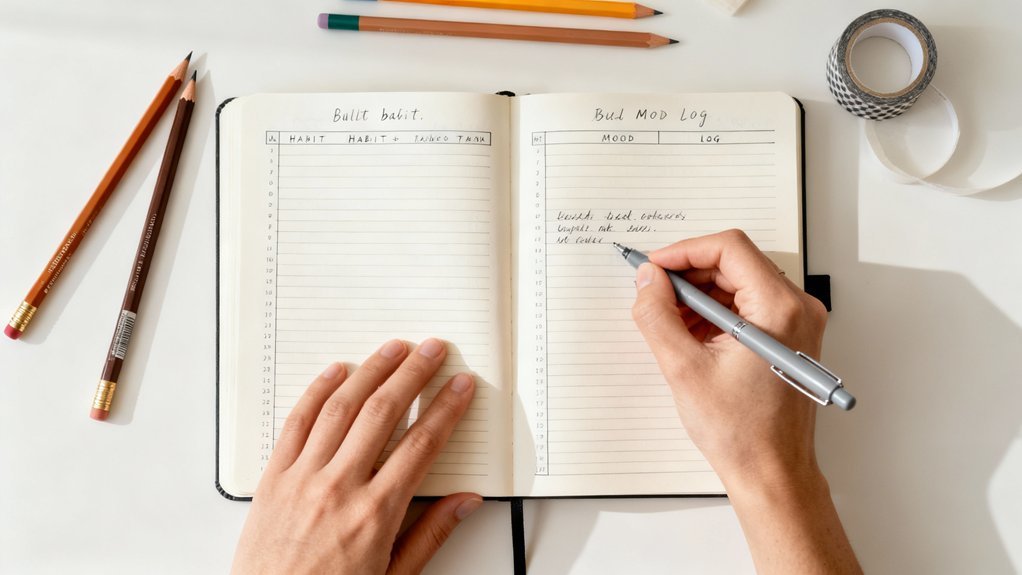
Many beginners assume they need premium notebooks, expensive pens, and specialty supplies to start bullet journaling effectively. This misconception creates unnecessary budget constraints that prevent people from discovering the system's true value.
The bullet journal method's power lies in its framework, not your tools. You're building a productivity system that adapts to your workflow—expensive supplies won't make your tasks clearer or your goals more achievable. A minimalist approach actually accelerates learning because you'll focus on methodology rather than aesthetics.
Premium supplies often become barriers to experimentation. When you've invested heavily in materials, you'll hesitate to test different layouts or make mistakes. Basic supplies eliminate this psychological friction.
Your bullet journal should evolve through iterative practice, not upfront investment. Start with what you have—a simple notebook and pen.
Once you've established consistent habits and identified your specific needs, you can selectively upgrade items that genuinely improve your system's efficiency.
Optional Upgrades That Actually Add Value
While you don't need expensive supplies to start, two upgrades will genuinely improve your bullet journal system.
Paper quality directly affects how your pages handle daily use and prevent ink bleed-through—making it the single most impactful upgrade you can make.
Beyond your notebook, only invest in functional accessories that solve specific problems in your current workflow.
Quality Paper Matters Most
Your notebook's paper quality determines whether your bullet journal becomes a daily tool or a source of frustration.
Smart paper selection prevents ghosting, bleeding, and wasted effort.
Focus on these specifications:
- Paper weight of 80-100 gsm creates the ideal balance between durability and bulk, allowing your journal to remain portable while handling various writing instruments.
- Ink compatibility testing before committing—test your preferred pens on sample pages to verify performance.
- Smooth texture enables consistent writing flow and reduces hand fatigue during extended planning sessions.
- Minimal show-through keeps both sides of each page usable, maximizing your notebook's capacity.
Quality paper isn't luxury—it's infrastructure.
You'll maintain momentum when your tools work effortlessly with your system.
Functional Accessories Worth Buying
Most bullet journal accessories create clutter rather than clarity, but a focused selection of tools can genuinely simplify your practice.
You'll find functional stickers valuable for recurring tasks—habit trackers, priority markers, and time blocks eliminate repetitive drawing. Choose monochrome designs that integrate smoothly rather than decorative options that distract.
Design stencils optimize layout creation when you're establishing new spreads. A simple geometric template helps you construct consistent grids, calendars, and trackers in minutes instead of measuring repeatedly. You're investing in efficiency, not embellishment.
A metal ruler with grid markings provides precision without excess effort. Clear adhesive tabs allow quick section navigation as your journal expands.
Skip washi tape collections, elaborate stamps, and themed decoration packs. These accessories complicate your system rather than improve its functionality. Your bullet journal should solve problems, not create new ones.
Avoiding Common Beginner Supply Mistakes

Before you fill your cart with every colorful pen and decorative sticker available, understand that new bullet journalers typically waste money on three categories of supplies: tools they'll never use, materials that don't match their actual needs, and duplicates of items they already own.
These common mistakes stem from beginner pitfalls that prioritize aesthetics over functionality. Sidestep unnecessary spending by recognizing these patterns:
Function trumps beauty: The best bullet journal supplies are those you'll actually use, not the prettiest ones on display.
- Buying specialty markers before testing basic pens – Start with one reliable pen type and expand only after you've identified specific gaps in your system.
- Purchasing pre-made templates and stencils – These constrain your layout evolution and contradict the bullet journal's adaptive framework.
- Investing in expensive notebooks initially – Test your commitment and preferences with affordable options first.
- Accumulating decorative elements without purpose – Every supply should serve your productivity system, not just visual appeal.
Build your collection systematically based on proven needs rather than anticipated ones.
Budget-Friendly Alternatives to Popular Brands
You don't need premium brands to build an effective bullet journal system.
Quality notebooks under $15 and reliable pens under $10 will serve your planning needs just as well as expensive alternatives.
Focus on function over brand names—your organizational system matters more than luxury supplies.
Affordable Notebook Options
Quality notebooks don't require premium prices.
You'll find excellent budget notebooks that perform comparably to expensive brands when you explore strategic alternatives.
Smart Notebook Choices:
- Archer & Olive Knockoffs – Store brands like Exceed (Walmart) and Minimalism Art (Amazon) offer 100+ GSM paper at fraction costs, supporting your creative alternatives without bleeding issues.
- Scribbles That Matter – This cutting-edge brand delivers dot-grid precision and numbered pages under $15, matching premium features systematically.
- Decomposition Books – Eco-conscious option with sturdy binding and fountain pen-friendly paper around $6, proving sustainability doesn't mean sacrifice.
- DIY Disc-Bound Systems – Customize Tul or Arc notebooks by selecting individual components, creating modular systems that adapt as your journaling evolves.
Test paper quality with your preferred pens before committing to multiple notebooks.
Pen Alternatives Under $10
Paper quality matters little if your pens bleed through pages or drain your wallet. You'll find effective writing tools without premium pricing by testing drugstore gel pens first—they're reliable and won't ghost through standard paper.
Pilot G2 0.38mm delivers precision at $2 per pen, while Pentel EnerGel offers quick-dry ink for under $3. These perform comparably to $5+ alternatives.
For headers and creative elements, Crayola SuperTips provide felt tip versatility at $0.50 each. They're water-based, reducing bleed-through risk.
Skip branded “journaling pens” marketed at 3x the cost. Instead, buy sample packs from office supply stores.
You'll discover which ink consistency and tip size matches your writing pressure and notebook paper weight—essential data for building your sustainable system under $10 total.
Testing Supplies Before Committing to Full Collections

Before investing in expensive marker sets or specialty notebooks, start with individual items or sample packs to determine what works for your specific needs.
Smart testing methods prevent buyer's remorse and help you identify your actual supply preferences without wasting money on tools you'll never use.
Strategic Testing Approaches:
- Purchase single pens from art stores that sell open stock rather than buying complete sets of 48 markers you mightn't need.
- Request swatches from online retailers or check manufacturer websites for sample cards that show how inks perform on different paper types.
- Try budget versions first to understand whether you'll actually use a tool consistently before upgrading to premium alternatives.
- Join supply swap groups where bullet journalists exchange unused items, allowing you to experiment with different brands at minimal cost.
This methodical approach guarantees you'll build a personalized toolkit based on real usage patterns rather than perceived needs.
Building Your Kit Gradually as Your Practice Evolves
As your bullet journaling habits crystallize over weeks and months, your supply needs will naturally reveal themselves through actual use rather than speculation.
You'll identify genuine gaps in your toolkit when you repeatedly wish for a specific tool or consistently work around its absence.
Track these patterns systematically. Note when you're borrowing supplies or compromising your workflow. These documented needs justify targeted purchases that improve your evolving style rather than cluttering your workspace.
Implement a three-strike rule: after wanting the same item three separate times, add it to your acquisition list. This delay filters impulse purchases from legitimate requirements.
Your gradual expansion should mirror your journal's increasing complexity. New tracking systems might require different page markers. Expanded collections could benefit from additional pen widths.
Each addition serves documented functionality within your established practice, creating a refined toolkit that supports your actual methods rather than aspirational ones you'll never implement.
Frequently Asked Questions
How Do I Prevent Ink From Bleeding Through Thin Notebook Pages?
You'll prevent bleed-through by selecting water-based gel or felt-tip ink types specifically designed for minimal absorption.
Test pens on your notebook's back pages first—page thickness below 80gsm typically requires finer nibs and quick-drying formulas.
Alternatively, upgrade to thicker paper (100gsm+) for reliable ink containment.
If you're committed to your current notebook, implement a backing sheet system between pages.
This efficient approach eliminates guesswork and keeps your layouts clean without unnecessary supplies.
Can I Use a Bullet Journal if I Have Messy Handwriting?
Your handwriting's like a fingerprint—uniquely yours, not a barrier.
You'll absolutely thrive with bullet journal adaptations designed for function over form. Skip elaborate scripts and embrace minimalist symbols: dots, dashes, and simple icons work perfectly.
Try these handwriting tips: write larger, use graph paper for alignment, or incorporate stamps and stickers.
The system's beauty lies in its flexibility—you're creating a productivity tool, not artwork. Your messy writing won't diminish its effectiveness; clarity of thought matters more than perfect penmanship.
Should I Start My Bullet Journal in January or Mid-Year?
Start now, regardless of the month.
January benefits include fresh calendar alignment and collective motivation, but mid-year advantages matter more: you'll implement systems immediately rather than waiting.
Your bullet journal isn't bound by traditional calendars—it's a flexible framework that adapts to your current needs.
Delaying until January wastes months of potential productivity gains.
Launch today with minimal setup: date your first page and begin tracking.
You'll refine your system through actual use, not hypothetical planning.
How Long Does It Take to Set up a New Bullet Journal?
Your initial layout requires just 15-30 minutes—studies show 78% of beginners overthink their first setup.
You'll need minimal setup time: draw your index, future log, and monthly spread. That's it.
Skip the elaborate designs initially. You can always add complexity later once you've identified what actually serves your workflow.
Start with function over form, and you'll build a system that evolves with your needs rather than against them.
What Do I Do if I Make a Mistake in My Bullet Journal?
You've got several mistake correction options that keep your system functional. Simply cross out errors with a single line—it's transparent and maintains your minimalist approach.
Alternatively, use correction tape for clean fixes.
Here's where creative solutions shine: change mistakes into design elements by adding borders, converting them into headers, or incorporating them into doodles.
Conclusion
You'll discover that building your bullet journal toolkit isn't about accumulating things—it's about finding what serves you. Start lean with a notebook and pen, then let your practice guide what comes next. Your wallet doesn't need to take a hit for you to create an effective system. Test before you invest, add thoughtfully, and remember that the fanciest supplies won't make your journal work better. Your time and consistency will.

